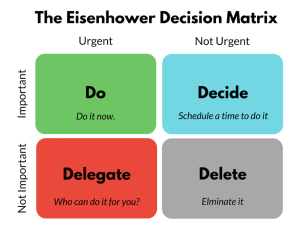TL;DR:
- Managing time effectively and maximizing every minute is essential for personal and professional success.
- Prioritize tasks with the Eisenhower Matrix to help you assess urgency with importance.
- Embrace the Pomodoro Technique by working for 25 minutes + 5-minute break intervals.
- Use the time-blocking technique to schedule specific blocks of time for different types of tasks.
- Eliminate distractions.
- Track your time.
5 Strategies to Improve Your Time Management
Time is one of our most valuable resources, and managing it effectively is essential for personal and professional success. The fact is, none of us feel like we have enough time to do all the things we need (and want) to do. As a teacher, you know this struggle better than most. You have pulled in so many different directions on a daily basis, have what seems like a never-ending to-do list, and work around (and through) more minute-to-minute changes and distractions than just about any other profession out there.
While I’d love to claim I know how to fix this for you, I don’t. However, working with thousands of educators over the past 8+ years, what I do know is that your time is limited as a whole. More so, the bits of time you do have that allow you to work on things outside of leading your classroom are typically shorter and rarely consistent throughout your days and weeks.
Time management is essential for personal and professional success. Remember, time is a precious resource, so use it wisely! Click To TweetAdd that to the numerous responsibilities on your plate, like lesson planning, grading, and managing extracurricular activities, it’s crucial that you maximize every minute you have to the best of your ability. As I said, I don’t have the perfect solution, but there are some strategies I have seen work extremely well for many people that might help you make the most of your time and cross a few more things off that list.
Here are 5 of those strategies for better time management.
1. Prioritize Tasks with the Eisenhower Matrix
The Eisenhower Matrix, also known as the Urgent-Important Matrix, is a time management tool that helps users prioritize tasks based on their urgency and importance (Eisenhower, n.d.). Renowned time management expert Stephen Covey explains, “The key is not to prioritize what’s on your schedule, but to schedule your priorities” (Covey, 1989).
By categorizing tasks in this way, you can focus on what truly matters, and avoid getting overwhelmed by less critical tasks. The matrix is separated into four categories:
- Quadrant 1: Urgent and Important (do it now)
- Quadrant 2: Important but Not Urgent (schedule time to do it)
- Quadrant 3: Urgent but Not Important (delegate if possible)
- Quadrant 4: Neither Urgent nor Important (forget about it)
To visualize your Eisenhower Matrix, divide a sheet of paper into four quadrants, labeling them like the above picture. Categorize the tasks on your list. Schedule time to address Quadrant 1 tasks first, followed by Quadrant 2 tasks. Minimize time spent on Quadrants 3 and 4. Update it regularly to stay on track with your priorities.
2. Embrace the Pomodoro Technique
The Pomodoro Technique is a time management method that involves breaking work into short, focused intervals (usually 25 minutes) called “Pomodoros” followed by a short break (Cirillo, 2006). This technique is particularly helpful for teachers as it allows them to concentrate on a single task for a set period of time, improving focus and productivity.
Example: Set a timer for 25 minutes to work on lesson planning, and then take a 5-minute break before starting another Pomodoro focused on grading papers.
3. Use Time Blocking
Time blocking is a technique where you schedule specific blocks of time for different types of tasks. This can help you stay focused and avoid multitasking, which can be a major time waster. Start by scheduling your most important tasks during your most productive hours. This will help you make the most of your time and avoid burnout. Use a timer to help you stay on track and avoid going over your allotted time for each task type.
[scroll down to keep reading]
4. Eliminate Distractions
This might seem like an obvious one. Distractions are one of the biggest time-wasters in our modern world. From social media notifications to email alerts, there are countless distractions vying for our attention. To eliminate distractions, try using tools like website blockers or apps that limit your time on social media. You can also try turning off notifications on your phone or setting specific times of day to check your email. It’s amazing how much this can help you stay focused and make the most of your already limited time.
5. Track Your Time
This is one of the best things I’ve ever done for my own productivity and time management. I use a free tool called Toggl to track everything I do. And I mean EVERYTHING. I know how much time I spend on each task, on getting coffee, taking breaks to walk my dog…everything.
Do you have to be as extreme as I am? No, not necessarily, but I recommend trying your best to track every minute of your days for at least two weeks. This will give you a clear picture of where you’re spending your time. Looking at this information and comparing where your time goes to where it should go according to your Eisenhower Matrix will give you direction on adjustments you need to make to be more efficient with your time.
Time management is essential for personal and professional success.
I encourage you to test at least one, if not all, of these strategies to improve your time management and efficiency. Remember, time is a precious resource, so use it wisely!
About Jeff Gargas
Jeff is the COO/Co-founder of the Teach Better Team and co-author of “Teach Better.” He works with educators to increase student engagement and improve student success. Jeff previously owned an online marketing firm, where he worked with entrepreneurs and small businesses. He is also a former adjunctive professor at Kent State University and spent 10+ years in the music industry.




